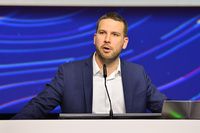
Bringing stroke teams together to act fast
- By Philips
- August 17 2024
- 2 min read
Seconds count when it comes to diagnosing and treating stroke patients. To connect hospitals and physicians and improve patient care, Philips partnered with medtech firm Nicolab, integrating its cloud-based stroke triage and management solution StrokeViewer into Philips end-to-end stroke care pathway. Doing so helps stroke teams work together quickly, 24/7, keeping the right information at their fingertips from the moment a stroke occurs to the moment the patient arrives in the interventional suite. This ensures that each patient gets the best possible chance of recovery.
At-a-glance:
- The faster a stroke patient receives a diagnosis and subsequent treatment, the faster the blood flow can be restored, and the higher the likelihood that the patient recovers.
- The patient’s stroke team receives instant notifications on their mobile devices and can view the patient’s vital information anytime, anywhere, enabling real-time decisions across departments and hospitals.
- This helps to ensure that eligible patients get sent directly to the interventional suite for treatment, giving them the best possible chance of recovery.

Collaborative care every step of the way
Up to 60% of stroke patients arrive at the hospital after office hours, meaning they are often treated by less experienced or junior staff.1,2 The Philips-Nicolab partnership helps to solve the critical bottlenecks in stroke treatment. Here’s how: Once the patient has been scanned, StrokeViewer uses artificial intelligence (AI) to analyze various stroke imaging biomarkers, helping to speed up diagnosis. The stroke team is able to communicate and collaborate with each other easily by sharing images from the mobile DICOM viewer which is certified for diagnostic use. When needed, teams can quickly share the patient’s images and details with a comprehensive center for endovascular (EVT) treatment.
StrokeViewer reduces the number of undetected large vessel occlusion (LVO) by 20%3 and the door-to-groin puncture time by 17%.4
This ensures that the patient avoids an unnecessary transfer or a rescan, and that they are diagnosed faster and arrive on time for treatment. The patient’s remote neurologist automatically receives a range of analyses of the scans (e.g. hemorrhage, large vessel occlusion detection, and perfusion analysis) to help assess the damage to their brain. StrokeViewer ensures that the interventional team at the comprehensive stroke center is kept in the loop so that they are prepared when the patient arrives. For example, physicians can review all relevant DICOM scans and AI results directly on Azurion, Philips’ image-guided therapy system, to determine eligibility for interventional treatment. The 3D planning view enables the interventional team to determine the best access route and viewing angles before the patient enters the interventional suite.
Philips is a collaborative and engaged partner with Nicolab. As a pioneer in stroke care, we work hand-in-hand with Philips to reduce the time for stroke patient diagnosis, connect physicians together, and improve treatment outcomes for patients.

Michael Macilquham
CEO of Nicolab
Faster stroke care in action
Watch the video below to find out how the Philips-Nicolab partnership is already helping Bicêtre Hospital, in Paris, France to improve stroke care collaboration.5

The app is available 24/7 so we can use it anytime, anywhere. If I don’t have access to my phone, I can see the images in Azurion without losing time or having to scrub out.

Dr. Jonathan Cortese
Interventional Neuroradiologist
Bicêtre Hospital, Paris, France
Copy this URLto share this story with your professional network
Sign up for news and updates

Footnotes
- Campbell, J, et al. The effect of out of hours presentation with acute stroke on processes of care and outcomes. PloS one, 9(2), e87946.
- Turner M, et al. Stroke patients admitted within normal working hours are more likely to achieve process standards and to have better outcomes, Journal of Neurology, 2016;87:138-143
- Fasen et al Neuroradiology 2022
- Multicenter Innovate study across a leading Hub and Spoke network in The Netherlands in 2020, data collection ongoing. Streamlined stroke workflow | StrokeViewer | Nicolab
- StrokeViewer is not available for sale in every market. Regulatory approval of AI functionality may vary per market. Please consult your local sales representative.
Disclaimer
Results are specific to the institution where they were obtained and may not reflect the results achievable at other institutions. Results in other cases may vary.